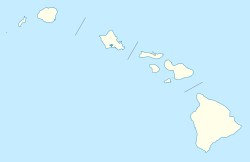Malia (canoe) facts for kids
Quick facts for kids |
|
|
Malia (Hawaiian canoe)
|
|
| Location | Jct. of Kapiolani Blvd. and McCully St., SE corner, Honolulu, Hawaii |
|---|---|
| Area | less than one acre |
| Built | 1933 |
| Architect | James Takeo Yamasaki |
| Architectural style | Wooden dugout canoe |
| NRHP reference No. | 93001385 |
| Added to NRHP | December 17, 1993 |
The Mālia is a famous Hawaiian racing canoe. It was built from beautiful blonde koa wood in 1933. A skilled craftsman named James Takeo Yamasaki made it in Kailua-Kona, Hawaii.
The Mālia's wooden hull (the main body of the boat) became the model for many other racing canoes. This includes newer canoes made from fiberglass. A famous canoe racer, Tommy Holmes, said that Mālia was one of the first canoes made just for racing. It is still a model for canoes today. In 1993, the Mālia was added to the State and National Register of Historic Places. This means it is an important historical item.
Contents
The Start of Canoe Racing
Outrigger canoe racing became very popular in Hawaiʻi in the early 1900s. Prince Jonah Kūhiō Kalaniana'ole loved this sport. He asked for the first canoe built just for racing, called the ʻAʻa, in 1902.
Even though the ʻAʻa weighed 620 pounds, it won many races. Over the next few decades, canoes became lighter and faster. People started changing common fishing canoe designs to make them better for racing.
Designing the Mālia Canoe
The Mālia canoe is about 40 feet long and weighs 400 pounds. James Takeo Yamasaki designed it. This canoe was the best wooden racing canoe design of its time. It set the standard for all future racing canoes.
The original Hawaiian name Mālie means "calm waters." This name refers to the calm Kona Coast on the leeward side of the Big Island. This is where the canoe was made.
The Outrigger Canoe Club bought the Mālia in 1940. Later, the Waikiki Surf Club owned it from 1948 until 1988.
Mālias Influence on Modern Canoes
Between 1950 and 1951, the Mālias design was updated by Froiseth, Downing, and Choy. In 1959, the original Mālia won the first outrigger canoe race to Catalina Island in California.
After this race, the Mālia had a huge impact on how racing canoes developed. Tommy Holmes explained that someone supposedly copied the Mālias design. They made a fiberglass copy, called a "plug," without permission. From this copy, many molds were made.
Most fiberglass canoes used in Hawaiʻi and California today came from these molds. So, the Mālia accidentally became the "parent" of many modern fiberglass canoes.
In 1960, a fiberglass Mālia model from California raced across the Molokaʻi Channel to Oʻahu. This led to a special racing group for Mālia-style fiberglass canoes from 1960 to 1978. By 1981, Mālia models were used in Australia, Britain, Canada, Japan, Samoa, and even across the United States.
Why the Mālia is Important Today
Today, the term Mālia canoe refers to a whole class of Hawaiian-style outrigger canoes. These canoes follow the original Mālias design, even if they are made of fiberglass.
However, every serious outrigger canoe club still wants to own at least one Mālia made from traditional koa wood. This shows how much respect they have for the original canoe and its history.


